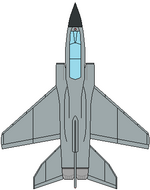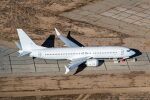Royal Onekawa-Nukanoa Air Force: Difference between revisions
m (Fixed broken wikipedia links) |
|||
| (4 intermediate revisions by one other user not shown) | |||
| Line 25: | Line 25: | ||
|equipment= | |equipment= | ||
|equipment_label= | |equipment_label= | ||
|battles= [[Onekawan Civil War of 1925]]<br>[[First Monsoon War]]<br>[[Second Monsoon War]] | |battles= [[Onekawan Civil War of 1925]]<br>[[First Monsoon War]]<br>[[Second Monsoon War]]<br>[[Fahrani Civil War]] | ||
|anniversaries= | |anniversaries= | ||
|decorations= | |decorations= | ||
| Line 77: | Line 77: | ||
|aircraft_transport= | |aircraft_transport= | ||
}} | }} | ||
The '''Royal Onekawa-Nukanoa Air Force''' (Onekawan: ''Te Tauarangi Roera o Onekawa-Nukanoa'') is the aerial and space warfare branch of the '''Royal Onekawa-Nukanoa Armed Forces''' (Onekawan: '' Te Ope Manuka o Onekawa-Nukanoa''). Established on the order of Māori Kingī [[Tama I Nukanoa]] in 1920 as distinct branch of the military, the Royal Onekawa-Nukanoa Air Force ('''RONAF''') has been engaged in every major armed conflict involving [[Onekawa-Nukanoa|Ngāti Onekawa-Nukanoa]] with the first major conflict being the [[Onekawan Civil War of 1925]]. With a current active strength of 42,000 and a reserve force of 4,000 the RONAF is the second largest service branch of the Royal Onekawa-Nukanoa Armed Forces. | |||
The | |||
=History= | =History= | ||
=Structure= | =Structure= | ||
==Doctrine== | ==Doctrine== | ||
The RONAF is primarily concerned in engaging peer or near-peer threats: and that the RONAF is likely to (a.) be engaged away from permeant Onekawan military facilities and support infrastructure and (b.) likely to be outnumbered against their opposition. In response to these major concerns, the RONAF has developed the "Total SICA" doctrine. An abbreviation of "SUPPORT, IDENTIFICATION, CONTAINMENT AND ANNIHILATION", the Total SICA doctrine governs the philosophy on how the RONAF conducts operations in the air and space domains. | |||
The "SUPPORT" pillar is to ensure that any Onekawan forces deployed receive adequate logistical support to sustain long term operations in the fulfillment of their mission, and that there should be a sufficient degree of redundancy in any logistical support system to handle unforeseen disruptions caused by enemy action or other means. This must also be achieved under the assumption that their is not necessarily any significant friendly local support facilities, personnel and infrastructure. | |||
=Fleet= | =Fleet= | ||
| Line 138: | Line 147: | ||
| {{flag|Onekawa-Nukanoa}} | | {{flag|Onekawa-Nukanoa}} | ||
| Suppression of Enemy Air Defences (SEAD) aircraft | | Suppression of Enemy Air Defences (SEAD) aircraft | ||
| | | 42 | ||
| Primary SEAD aircraft | | Primary SEAD aircraft | ||
|----- | |----- | ||
| Line 159: | Line 168: | ||
| {{flag|Onekawa-Nukanoa}} | | {{flag|Onekawa-Nukanoa}} | ||
| Strategic/Tactical Transport | | Strategic/Tactical Transport | ||
| | | 54 | ||
| Standard service airlifter | | Standard service airlifter | ||
|----- | |----- | ||
| Line 165: | Line 174: | ||
|- style="background:#efefef; color:black" | |- style="background:#efefef; color:black" | ||
| [[Ahuriri Aerospace R510|Tītī KC.9]] | | [[Ahuriri Aerospace R510|Tītī KC.9]] | ||
| [[File: | | [[File:Boeing_KC-767J_tanker_of_the_JASDF_(code_87-3601)_at_RIAT_Fairford_17July2017_arp.jpg|150px]] | ||
| {{flag|Onekawa-Nukanoa}} | | {{flag|Onekawa-Nukanoa}} | ||
| Aerial Tanker | | Aerial Tanker | ||
| | | 19 | ||
| Standard service aerial tanker | | Standard service aerial tanker | ||
|----- | |----- | ||
|- | |- | ||
|- style="background:#efefef; color:black" | |- style="background:#efefef; color:black" | ||
| {{wpl| | | {{wpl|Beechcraft_Super_King_Air|Pīkikau C.1}} | ||
| [[File:Royal_Air_Force_King_Air_B200_Training_Aircraft_MOD_45153010.jpg|150px]] | | [[File:Royal_Air_Force_King_Air_B200_Training_Aircraft_MOD_45153010.jpg|150px]] | ||
| {{flag|Onekawa-Nukanoa}} | | {{flag|Onekawa-Nukanoa}} | ||
| Line 212: | Line 221: | ||
|- | |- | ||
|- style="background:#efefef; color:black" | |- style="background:#efefef; color:black" | ||
| {{wpl| | | {{wpl|Alenia_Aermacchi_M-346_Master|Nākahi II TF.1}} | ||
| [[File:M346_-_RIAT_2009_(3834484695).jpg|150px]] | | [[File:M346_-_RIAT_2009_(3834484695).jpg|150px]] | ||
| {{flag|Onekawa-Nukanoa}} | | {{flag|Onekawa-Nukanoa}} | ||
| Line 221: | Line 230: | ||
|- | |- | ||
|- style="background:#efefef; color:black" | |- style="background:#efefef; color:black" | ||
| {{wpl| | | {{wpl|Beechcraft_King_Air|Kau TM.2}} | ||
| [[File:Tc-90_04l.jpg|150px]] | | [[File:Tc-90_04l.jpg|150px]] | ||
| {{flag|Onekawa-Nukanoa}} | | {{flag|Onekawa-Nukanoa}} | ||
| Line 230: | Line 239: | ||
|- | |- | ||
|- style="background:#efefef; color:black" | |- style="background:#efefef; color:black" | ||
| {{wpl| | | {{wpl|Embraer_EMB_314_Super_Tucano|Pī TB.3}} | ||
| [[File:A-29_Over_Afghanistan.jpg|150px]] | | [[File:A-29_Over_Afghanistan.jpg|150px]] | ||
| {{flag|Onekawa-Nukanoa}} | | {{flag|Onekawa-Nukanoa}} | ||
| Line 276: | Line 285: | ||
| Primary SIGINT aircraft | | Primary SIGINT aircraft | ||
|----- | |----- | ||
|- | |||
|- style="background:#efefef; color:black" | |||
| [[Ahuriri Aerospace R510|Ngawī R.9]] | |||
| [[File:Colombian_Air_Force_Boeing_KC-767-2J6ER_Lofting-1.jpg|150px]] | |||
| {{flag|Onekawa-Nukanoa}} | |||
| Airborne ground surveillance, battle management and command and control aircraft. | |||
| 4 | |||
| Primary JSTARS aircraft | |||
|----- | |||
|} | |||
|} | |} | ||
{| class="wikitable" | {| class="wikitable" | ||
| Line 311: | Line 330: | ||
|- | |- | ||
|- style="background:#efefef; color:black" | |- style="background:#efefef; color:black" | ||
| {{wpl| | | {{wpl|Northrop_Grumman_RQ-4_Global_Hawk|Rangipākau R.1}} | ||
| [[File:Global_Hawk,_NASA's_New_Remote-Controlled_Plane_-_October_2009.jpg|150px]] | | [[File:Global_Hawk,_NASA's_New_Remote-Controlled_Plane_-_October_2009.jpg|150px]] | ||
| {{flag|Belfras}} | | {{flag|Belfras}} | ||
| Line 320: | Line 339: | ||
|- | |- | ||
|- style="background:#efefef; color:black" | |- style="background:#efefef; color:black" | ||
| {{wpl| | | {{wpl|General_Atomics_MQ-9_Reaper|Kōkōpākau RS.3}} | ||
| [[File:Reaper_UAV_Takes_to_the_Skies_of_Southern_Afghanistan_MOD_45151418.jpg|150px]] | | [[File:Reaper_UAV_Takes_to_the_Skies_of_Southern_Afghanistan_MOD_45151418.jpg|150px]] | ||
| {{flag|Onekawa-Nukanoa}} | | {{flag|Onekawa-Nukanoa}} | ||
Latest revision as of 14:24, 29 January 2023
This article is incomplete because it is pending further input from participants, or it is a work-in-progress by one author. Please comment on this article's talk page to share your input, comments and questions. Note: To contribute to this article, you may need to seek help from the author(s) of this page. |
| Royal Onekawa-Nukanoa Air Force | |
|---|---|
| Te Tauarangi Roera o Onekawa-Nukanoa | |
| Active | 1920 - present |
| Country | Ngāti Onekawa-Nukanoa |
| Allegiance | Te Ope Manuka o Onekawa-Nukanoa/Royal Onekawa-Nukanoa Armed Forces |
| Branch | Air Force |
| Size | 42,000 (active), 4,000 (reserve) |
| Engagements | Onekawan Civil War of 1925 First Monsoon War Second Monsoon War Fahrani Civil War |
The Royal Onekawa-Nukanoa Air Force (Onekawan: Te Tauarangi Roera o Onekawa-Nukanoa) is the aerial and space warfare branch of the Royal Onekawa-Nukanoa Armed Forces (Onekawan: Te Ope Manuka o Onekawa-Nukanoa). Established on the order of Māori Kingī Tama I Nukanoa in 1920 as distinct branch of the military, the Royal Onekawa-Nukanoa Air Force (RONAF) has been engaged in every major armed conflict involving Ngāti Onekawa-Nukanoa with the first major conflict being the Onekawan Civil War of 1925. With a current active strength of 42,000 and a reserve force of 4,000 the RONAF is the second largest service branch of the Royal Onekawa-Nukanoa Armed Forces.
The
History
Structure
Doctrine
The RONAF is primarily concerned in engaging peer or near-peer threats: and that the RONAF is likely to (a.) be engaged away from permeant Onekawan military facilities and support infrastructure and (b.) likely to be outnumbered against their opposition. In response to these major concerns, the RONAF has developed the "Total SICA" doctrine. An abbreviation of "SUPPORT, IDENTIFICATION, CONTAINMENT AND ANNIHILATION", the Total SICA doctrine governs the philosophy on how the RONAF conducts operations in the air and space domains.
The "SUPPORT" pillar is to ensure that any Onekawan forces deployed receive adequate logistical support to sustain long term operations in the fulfillment of their mission, and that there should be a sufficient degree of redundancy in any logistical support system to handle unforeseen disruptions caused by enemy action or other means. This must also be achieved under the assumption that their is not necessarily any significant friendly local support facilities, personnel and infrastructure.
Fleet
Fixed Wing Aircraft
| Name | Image | Origin | Type/Variants | Number in Service | Details | |
|---|---|---|---|---|---|---|
| Fighters | ||||||
| Whaitiri Kāhu FSR.7 | 
|
Multirole fighter | 182 | Standard service fighter | ||
| Haumātakataka FSR.1 | 
|
Heavy multirole fighter | 122 | Standard heavy fighter | ||
| Karearea FSR.1 | Multirole stealth fighter | 31 | Standard service stealth fighter. Additional 17 aircraft on order | |||
| Name | Image | Origin | Type/Variants | Number in Service | Details | |
|---|---|---|---|---|---|---|
| Electronic Warfare | ||||||
| Whaitiri Kāhu ER.4 | 
|
Suppression of Enemy Air Defences (SEAD) aircraft | 42 | Primary SEAD aircraft | ||
| Name | Image | Origin | Type/Variants | Number in Service | Details | |
|---|---|---|---|---|---|---|
| Air Mobility | ||||||
| Kererū C.2 | 
|
Strategic/Tactical Transport | 54 | Standard service airlifter | ||
| Tītī KC.9 | 
|
Aerial Tanker | 19 | Standard service aerial tanker | ||
| Pīkikau C.1 | 
|
Utility Transport | 13 | Standard utility transport | ||
| Tūmatarau Whāriki II VC.2 | 
|
VIP Transport | 2 | Former primary VIP Transport, relegated to support and secondary officials and royals | ||
| Tūmatarau Whāriki III VC.1 | 
|
VIP Transport | 2 | Primary VIP Transport for the primary official and royals | ||
| Name | Image | Origin | Type/Variants | Number in Service | Details | |
|---|---|---|---|---|---|---|
| Training | ||||||
| Nākahi II TF.1 | 
|
Lead-In Fighter Trainer | 22 | Standard service Lead-In Fighter trainer | ||
| Kau TM.2 | 
|
Basic Multi-Engine Trainer | 7 | Standard service multi-engine trainer | ||
| Pī TB.3 | 
|
Basic Trainer | 66 | Standard service basic trainer | ||
| Name | Image | Origin | Type/Variants | Number in Service | Details | |
|---|---|---|---|---|---|---|
| Surveillance/Support Aircraft | ||||||
| Karaurangi AEW.1 | 
|
Airborne Early Warning and Control Aircraft | 8 | Primary airborne early warning and control aircraft | ||
| Karawhenua R.6 | 
|
Intelligence, surveillance, target acquisition, and reconnaissance (ISTAR) aircraft | 3 | Primary ISTAR aircraft | ||
| Koekoe R.3 | 
|
Signal Intelligence gathering aircraft | 3 | Primary SIGINT aircraft | ||
| Ngawī R.9 | 
|
Airborne ground surveillance, battle management and command and control aircraft. | 4 | Primary JSTARS aircraft | ||
|}
| Name | Image | Origin | Type/Variants | Number in Service | Details | |
|---|---|---|---|---|---|---|
| Maritime Patrol Aircraft | ||||||
| Wharenga II MPA.1 | 
|
Maritime Patrol Aircraft | 8 | Primary maritime patrol aircraft | ||
| Name | Image | Origin | Type/Variants | Number in Service | Details | |
|---|---|---|---|---|---|---|
| Unmanned Aerial Vehicles | ||||||
| Rangipākau R.1 | 
|
Long Endurance Reconnaissance Aircraft | 8 | Strategic unmanned reconnaissance aircraft | ||
| Kōkōpākau RS.3 | 
|
Long Endurance Reconnaissance and Light Strike Aircraft | 18 | Tactical unmanned reconnaissance and strike aircraft | ||